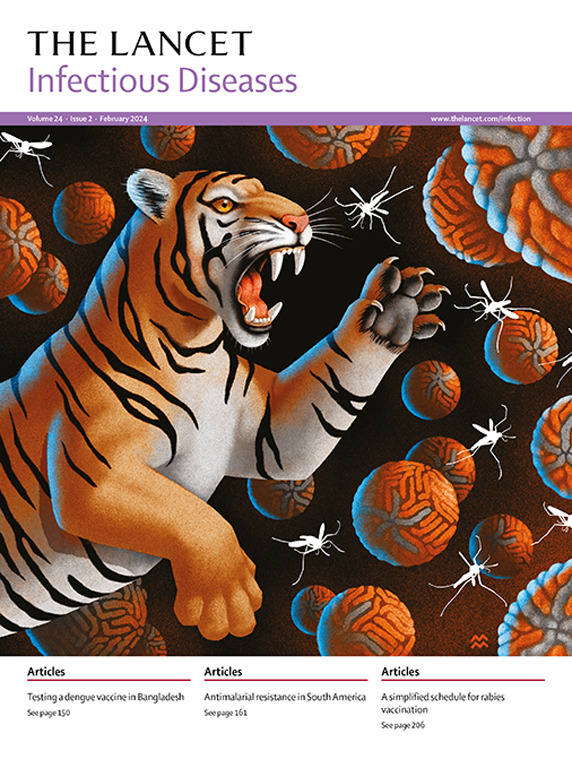人畜共患博纳病病毒1型感染的神经病理学、发病机制和传播:系统综述
IF 36.4
1区 医学
Q1 INFECTIOUS DISEASES
引用次数: 0
摘要
博纳病是一种主要影响马和羊的严重脑炎,人们在两个多世纪前就发现了它。博纳病病毒1型(BoDV-1)已被确定为人类主要致命脑炎的病因。关于病毒的传播、进入门户和排泄途径的科学数据很少。在宿主和终端宿主中,病变模式、免疫反应和发病机制在很大程度上仍未被探索。本系统综述整理了这些方面的现有知识,并为今后的研究提供指导。PubMed, ScienceDirect和EBSCO检索了2000年1月1日至2024年4月30日的出版物。共发现823份记录,其中纳入41项研究。这篇系统综述讨论了BoDV-1在宿主和终端宿主中的传播、发病机制、组织病理学变化和免疫学,并特别关注人类。在人类中,确切的传播机制、入口和病毒在中枢神经系统内的传播尚不完全清楚。尽管在动物身上有更多的数据,但很多仍是假设。未来的研究应侧重于确定潜在的进入位点和病毒在终端宿主中的传播,这将有助于阐明BoDV-1在中枢神经系统中的发病机制和病变分布,从而有助于更好地了解人类感染BoDV-1及其与动物感染的相似之处。本文章由计算机程序翻译,如有差异,请以英文原文为准。
Neuropathology, pathomechanism, and transmission in zoonotic Borna disease virus 1 infection: a systematic review
Borna disease, which is a severe encephalitis that primarily affects horses and sheep, has been recognised for over two centuries. Borna disease virus 1 (BoDV-1) has been identified as a cause of a predominantly fatal encephalitis in humans. Little scientific data exist regarding the virus' transmission, entry portal, and excretion routes. Lesional patterns, immunological responses, and pathogenetic mechanisms remain largely unexplored in both reservoir and dead-end hosts. This systematic review compiles current knowledge on these aspects and provides guidance for future research. PubMed, ScienceDirect, and EBSCO were searched for publications from Jan 1, 2000, to April 30, 2024. 823 records were found, of which 41 studies were included. This systematic review discusses BoDV-1 transmission, pathogenesis, histopathological changes, and immunology in both reservoir and dead-end hosts, with special regard for humans. The exact propagation mechanisms, entry portal, and viral spread within the CNS are not entirely clear in humans. Although more data exist in animals, much remains hypothetical. Future research should focus on identifying potential entry sites and viral spread in dead-end hosts, which could help to clarify the pathogenesis and lesion distribution in the CNS, thereby contributing to a better understanding of BoDV-1 infection in humans and parallels with animal infections.
求助全文
通过发布文献求助,成功后即可免费获取论文全文。
去求助
来源期刊

Lancet Infectious Diseases
医学-传染病学
CiteScore
60.90
自引率
0.70%
发文量
1064
审稿时长
6-12 weeks
期刊介绍:
The Lancet Infectious Diseases was launched in August, 2001, and is a lively monthly journal of original research, review, opinion, and news covering international issues relevant to clinical infectious diseases specialists worldwide.The infectious diseases journal aims to be a world-leading publication, featuring original research that advocates change or sheds light on clinical practices related to infectious diseases. The journal prioritizes articles with the potential to impact clinical practice or influence perspectives. Content covers a wide range of topics, including anti-infective therapy and immunization, bacterial, viral, fungal, and parasitic infections, emerging infectious diseases, HIV/AIDS, malaria, tuberculosis, mycobacterial infections, infection control, infectious diseases epidemiology, neglected tropical diseases, and travel medicine. Informative reviews on any subject linked to infectious diseases and human health are also welcomed.
 求助内容:
求助内容: 应助结果提醒方式:
应助结果提醒方式:


